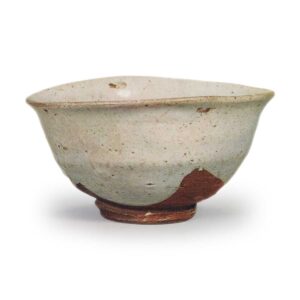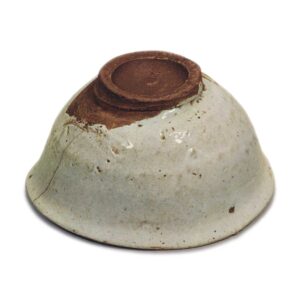

Kate Teacup Nagasaki
Chuko Specialty
Important Cultural Property
Nezu Museum
Height: 7.0-8.0cm
Mouth diameter: 13.4-14.7cm
Outer diameter of base: 5.5 cm
Height: 1.0cm
This tea bowl is one of the most famous of the katate types, and is inscribed “Nagasaki” after Nagasaki Shosai (Kyutayu), a physician in Kyoto, and was later cherished by Kobori Enshu, making it a Chukoh masterpiece.
The clay is hard and porcelain-like, and the handle is firm, but the workmanship is completely clay-like, light and careless, and has a deep tea flavor. The body is slightly thicker and the edge of the mouth is deeply curved, and the body is roughly turned on the potter’s wheel. The stand is thin and has strong bamboo joints, and the width of the helmet stands out in a rounded gouge. The light and delicate molding is slightly distorted, which adds to the charm of this piece. The free and flexible style, which is rare among hard wares, is a major characteristic of Nagasaki.
The glaze surface is a pale blue-white color, with an earthen appearance below the base, and there are variations in the breakage of the glaze. There are creases on the bottom due to scraping. There are three eyes, a horizontal scratch on the prospect, and a penetration from the mouth to the body.
Most of the kote that are prized as tea bowls are believed to have been produced at the Kinhai kiln, and Nagasaki can be considered to be one of them. The kotate ame leak, which has been handed down from the Sakai family, is thought to be one of the relatively early examples of such kotate ame leak. The next Goshomaru Tea Bowl is also Kinhai, and judging from the glaze tone, Nagasaki is probably about the same period as this one. The thin Kinkai tea bowl seems to have been made a little later, in the early Edo period. The old hard handles are soft with a thick glaze, but as time goes by, the base becomes tighter and harder, the handles become heavier, and the glaze becomes thinner. This tendency can be seen in kinkai katate no goshomaru.
Kagami-ochi, also called “mirror,” refers to a ring-shaped depression in the prospective surface, and is one of the characteristics of Kumagawa and Tamagotate. This type of depression is also common in katate, and is probably based on the use of a “tote” (iron) for the prospect, but in essence, all of these hands are from the Gyeongsangnamdo region, and the details of their techniques are similar. The rounded gouges in the Nagasaki elevation are common to those of Kumagawa and Tamagotate, but they are also reminiscent of those of Ko-Karatsu Okukoryo, which is very interesting.
Inner box, inscription on the cover: “Nagasaki” by Kobori Enshu
Outer box with inscription on the lid “Nagasaki Kate” by Matsudaira Fumai
Originally in the possession of Nagasaki Shosai, it later entered the collection of Kobori Enshu and was cherished by him. Around the time of the Meiji Restoration, Matsudaira Fumai, the feudal lord of Matsue, Unshu, requested the Kompongho hermitage owner, Shinkai, and received it for 400 ryo, and it was handed down in the family from then on.



